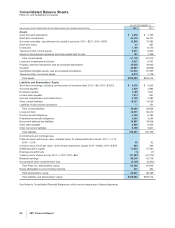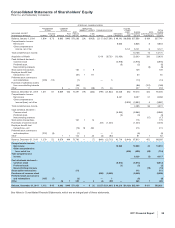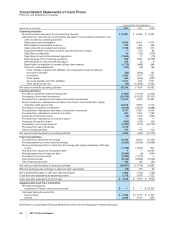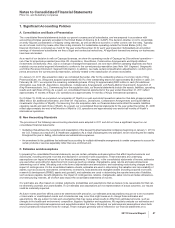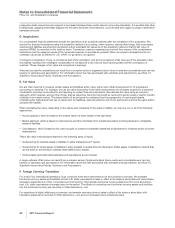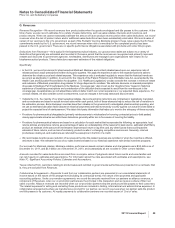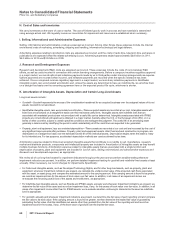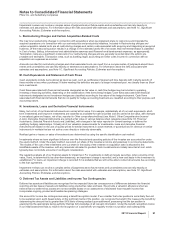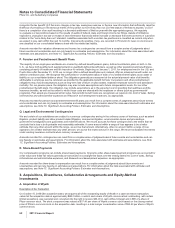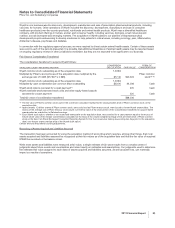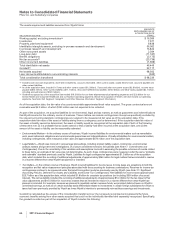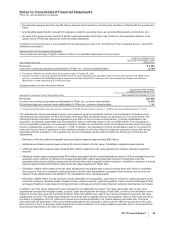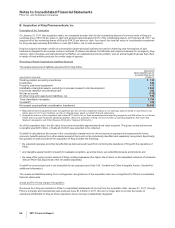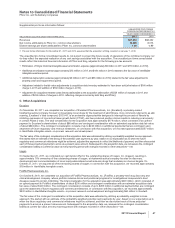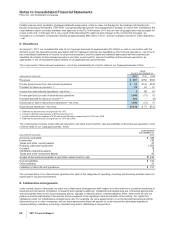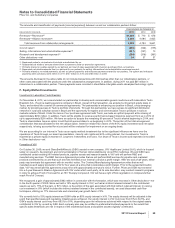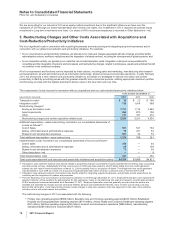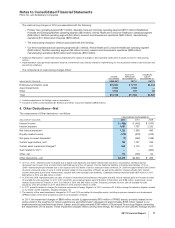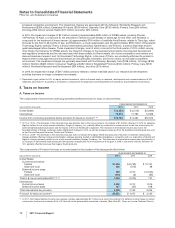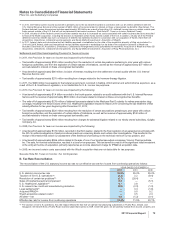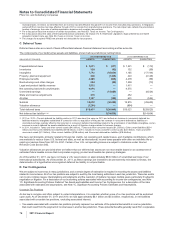Pfizer 2011 Annual Report Download - page 65
Download and view the complete annual report
Please find page 65 of the 2011 Pfizer annual report below. You can navigate through the pages in the report by either clicking on the pages listed below, or by using the keyword search tool below to find specific information within the annual report.
Notes to Consolidated Financial Statements
Pfizer Inc. and Subsidiary Companies
The assets acquired and liabilities assumed from Wyeth follow:
(MILLIONS OF DOLLARS)
AMOUNTS
RECOGNIZED AS OF
ACQUISITION DATE
(FINAL)
Working capital, excluding inventories(a) $ 16,366
Inventories 7,971
Property, plant and equipment 9,838
Identifiable intangible assets, excluding in-process research and development 36,062
In-process research and development 13,822
Other noncurrent assets 2,394
Long-term debt (11,187)
Benefit obligations (3,175)
Net tax accounts(b) (23,738)
Other noncurrent liabilities (1,908)
Total identifiable net assets 46,445
Goodwill(c) 22,117
Net assets acquired 68,562
Less: Amounts attributable to noncontrolling interests (326)
Total consideration transferred $ 68,236
(a) Includes cash and cash equivalents, short-term investments, accounts receivable, other current assets, assets held for sale, accounts payable and
other current liabilities.
(b) As of the acquisition date, included in Taxes and other current assets ($1.2 billion), Taxes and other noncurrent assets ($2.8 billion), Income taxes
payable ($500 million), Other current liabilities ($11.1 billion), Noncurrent deferred tax liabilities ($14.0 billion) and Other taxes payable ($2.1 billion,
including accrued interest of $300 million).
(c) Goodwill recognized as of the acquisition date totaled $19.3 billion for our three biopharmaceutical operating segments and $2.8 billion for our
Animal Health and Consumer Healthcare and our Nutrition operating segments. (Since the acquisition of Wyeth, we have revised our operating
segments. See Note 18A. Segment, Geographic and Other Revenue Information: Segment Information.)
As of the acquisition date, the fair value of accounts receivable approximated book value acquired. The gross contractual amount
receivable was $4.2 billion, of which $140 million was not expected to be collected.
As part of the acquisition, we acquired liabilities for environmental, legal and tax matters, as well as guarantees and indemnifications
that Wyeth incurred in the ordinary course of business. These matters can include contingencies. Except as specifically excluded by
the relevant accounting standard, contingencies are required to be measured at fair value as of the acquisition date, if the
acquisition-date fair value of the asset or liability arising from a contingency can be determined. If the acquisition-date fair value of
the asset or liability cannot be determined, the asset or liability would be recognized at the acquisition date if both of the following
criteria were met: (i) it is probable that an asset existed or that a liability had been incurred at the acquisition date, and (ii) the
amount of the asset or liability can be reasonably estimated.
•Environmental Matters––In the ordinary course of business, Wyeth incurred liabilities for environmental matters such as remediation
work, asset retirement obligations and environmental guarantees and indemnifications. Virtually all liabilities for environmental matters,
including contingencies, were measured at fair value and approximated $570 million as of the acquisition date.
•Legal Matters––Wyeth was involved in various legal proceedings, including product liability, patent, commercial, environmental,
antitrust matters and government investigations, of a nature considered normal to its business (see Note 17. Commitments and
Contingencies). Due to the uncertainty of the variables and assumptions involved in assessing the possible outcomes of events related
to these items, an estimate of fair value was not determinable. As such, these contingencies were measured under the same “probable
and estimable” standard previously used by Wyeth. Liabilities for legal contingencies approximated $1.3 billion as of the acquisition
date, which included the recording of additional adjustments of approximately $260 million for legal matters that we intended to resolve
in a manner different from what Wyeth had planned or intended.
•Tax Matters––In the ordinary course of business, Wyeth incurred liabilities for income taxes.Income taxes are exceptions to both the
recognition and fair value measurement principles associated with the accounting for business combinations. Reserves for income tax
contingencies continue to be measured under the benefit recognition model as previously used by Wyeth (see Note 1O. Significant
Accounting Policies: Deferred Tax Assets and Liabilities and Income Tax Contingencies). Net liabilities for income taxes approximated
$23.7 billion as of the acquisition date, which included $1.8 billion for uncertain tax positions (not including $300 million of accrued
interest). The net tax liability included the recording of additional adjustments of approximately $14.4 billion for the tax impact of fair
value adjustments and $10.5 billion for income tax matters that we intended to resolve in a manner different from what Wyeth had
planned or intended. For example, because we planned to repatriate certain overseas funds, we provided deferred taxes on Wyeth’s
unremitted earnings, as well as on certain book/tax basis differentials related to investments in certain foreign subsidiaries for which no
taxes had been previously provided by Wyeth as it was Wyeth’s intention to permanently reinvest those earnings and investments.
Goodwill is calculated as the excess of the consideration transferred over the net assets recognized and represents the future
economic benefits arising from other assets acquired that could not be individually identified and separately recognized. Specifically,
the goodwill recorded as part of the acquisition of Wyeth includes the following:
64 2011 Financial Report


